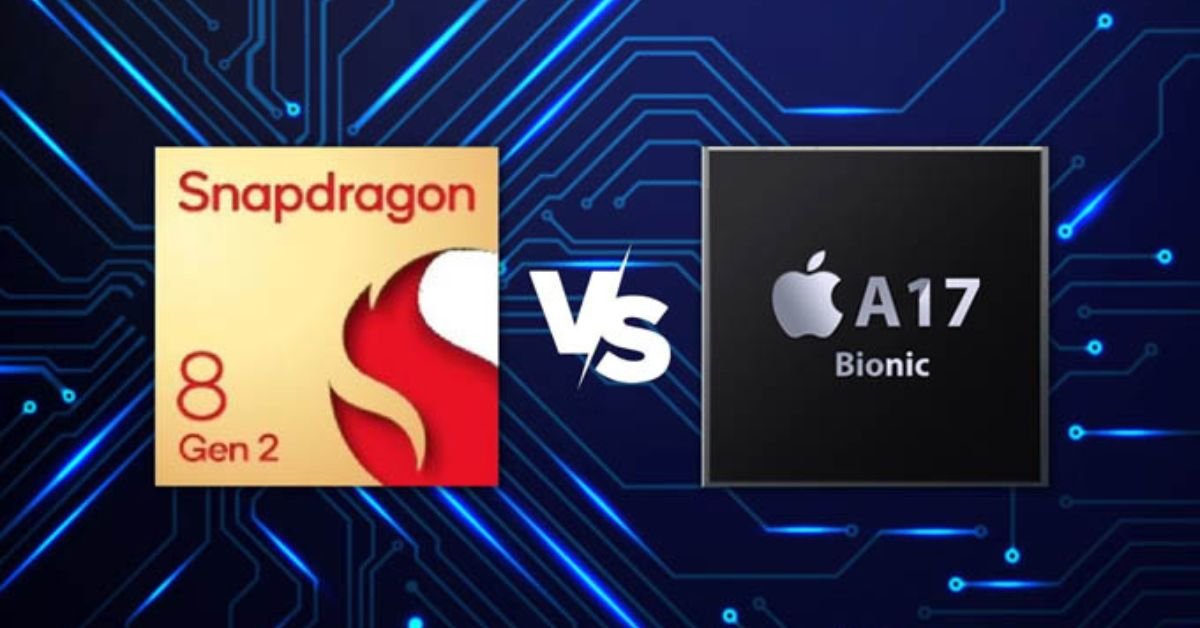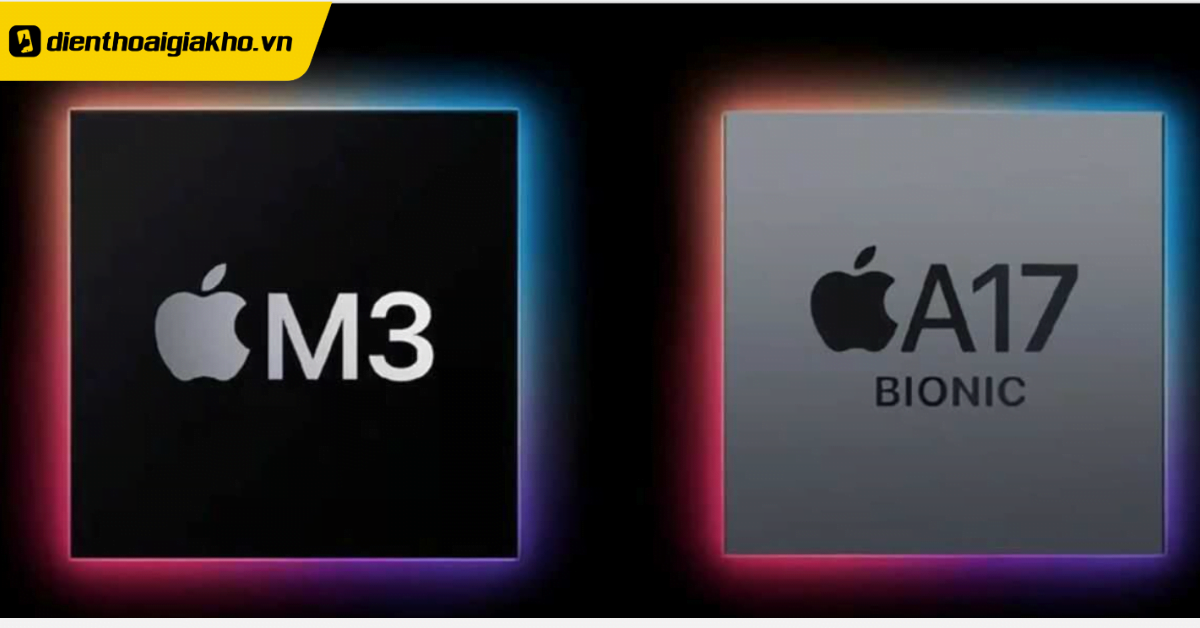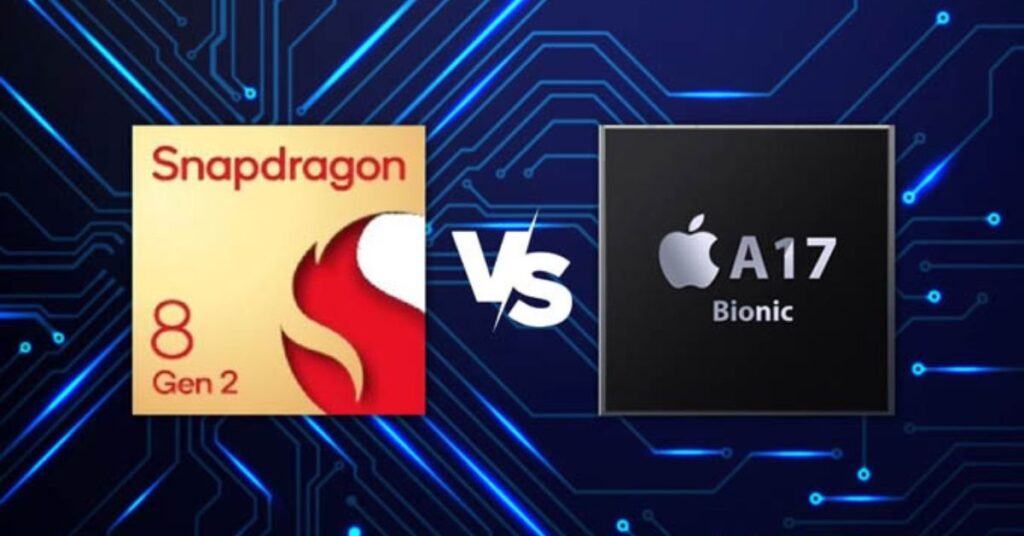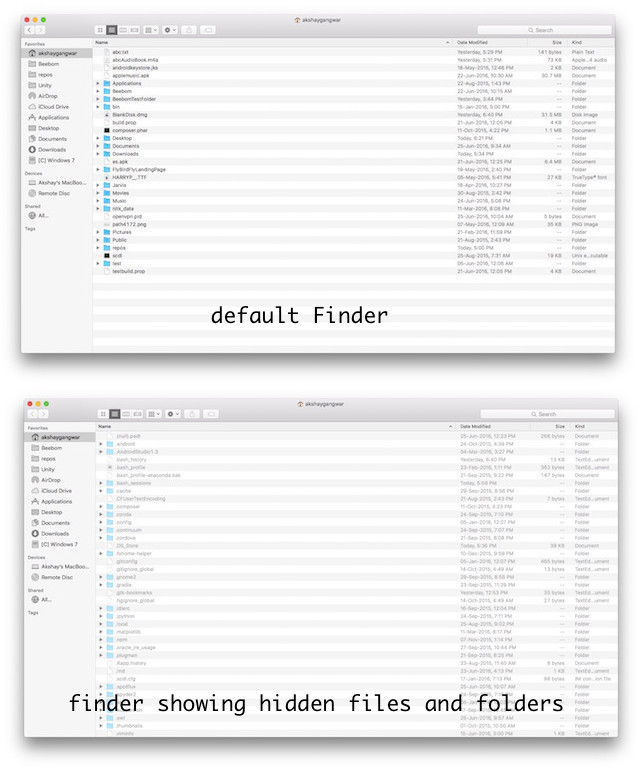
Apple unveiled the iPhone 15 Pro series and introduced its fastest mobile processor yet, the A17 Pro. It has dropped the “Bionic” label to better match the Pro series. The A17 Pro features a redesigned GPU, efficient CPU, powerful Neural engine, and more. But how does it compare to the Qualcomm Snapdragon 8 Gen 2 processor? Let’s compare the Apple A17 Pro and Snapdragon 8 Gen 2.
A17 Pro vs Snapdragon 8 Gen 2: Specifications
Here’s a comparison of the specifications between the Apple A17 Pro and Snapdragon 8 Gen 2, giving an overview of both mobile processors.
| Specs | Apple A17 Pro | Snapdragon 8 Gen 2 |
|---|---|---|
| CPU | Six-core CPU, 19 billion transistors | Octa-core, Kryo CPU |
| CPU Cores | 2x High-performance cores 4x High-efficiency cores |
1x 3.2GHz (Cortex-X3) 2x 2.8GHz (Cortex-A715) 2x 2.8GHz (Cortex-A710) 3x 2.0GHz (Cortex-A510) |
| Process Technology | TSMC’s 3nm process | TSMC’s 4nm process |
| GPU | Apple Pro-class 6-core GPU Hardware-accelerated Ray Tracing |
Adreno 740 GPU; Hardware-accelerated Ray Tracing |
| Memory Support | LPDDR5 | LPDDR5X |
| Machine Learning and AI | 16-core Neural Engine; 35 TOPS | New AI Engine, Hexagon Processor |
| ISP | Apple-designed Image Signal Processor | Triple 18-Bit Spectra ISP; Cognitive ISP, Snapdragon Sight |
| Camera Capability | ProRAW photos at 48MP Photonic Engine |
Capture photos up to 200MP, 36MP triple shots with ZSL |
| Video Capability | 4K60 ProRes videos Spatial video recording 4K HDR Dolby Vision @ 60FPS Cinematic 4K@24FPS Action mode |
8K HDR, Bokeh Engine 2 |
| Modem | Snapdragon X70 5G modem Up to 10 Gbps Peak Download Up to 3.5 Gbps Peak Upload |
Snapdragon X70 5G modem Up to 10 Gbps Peak Download Up to 3.5 Gbps Peak Upload |
| WiFi Support | Wi-Fi 6E | Wi-Fi 7 |
| Bluetooth | Bluetooth 5.3 | Bluetooth 5.3, LE Audio, Dual Bluetooth Antenna, aptX Lossless |
| Others | AV1 Decoder ProRes codec Pro display engine NavIC Support |
AV1 Codec Support NavIC Support |
A17 Pro vs Snapdragon 8 Gen 2: CPU
Comparing Apple’s A17 Pro and Qualcomm’s Snapdragon 8 Gen 2, let’s start with the CPU. Apple employs its usual six-core setup. Notably, the A17 Pro marks the first chip mass-produced on TSMC’s 3nm node, likely using the initial N3B process, yielding 19 billion transistors on one die.
A17 Pro CPU Cores
The CPU features two high-performance cores clocked at 3.70 GHz, boasting a 10% performance boost compared to the previous Everest cores. Additionally, Apple has integrated four power-efficient CPU cores, identified as the most efficient mobile CPU core by Apple. It delivers 3x performance per watt compared to competitors, likely referencing the A510 core. Thus, Apple has excelled in both CPU performance and efficiency with the A17 Pro, thanks to TSMC’s cutting-edge 3nm process node.
Regarding the year-old Snapdragon 8 Gen 2, it’s built on TSMC’s 4nm node (N4 process) and features an octa-core CPU design. It includes a 1+(2+2)+3 CPU cluster design comprising a single powerful Cortex-X3 core at 3.2GHz, 2x Cortex-A715 cores at 2.8GHz, 2x Cortex-A710 cores at 2.8GHz, and 3x Cortex-A510 cores at 2.0GHz.
Notice that the prime core speed of Snapdragon 8 Gen 2 is 3.2GHz, notably lower than A17 Pro’s 3.70GHz. A17 Pro is poised to excel in single-threaded tasks. Even considering the leaked CPU details of the upcoming Snapdragon 8 Gen 3 chip, Qualcomm may not surpass Apple this year. Snapdragon 8 Gen 3 is expected to feature a (1+3+2+2) CPU design with a prime Cortex-X4 core clocked at 3.39GHz, still below 3.70GHz.
Here are the Geekbench 6 scores of all three chips. Leaked scores of Snapdragon 8 Gen 3 should be taken cautiously as OEMs continue to optimize the chip for peak performance.
| Single-core (Geekbench 6) | Multi-core (Geekbench 6) | |
|---|---|---|
| Apple A17 Pro (Leaked) | 3269 | 7666 |
| Snapdragon 8 Gen 2 | 1867 | 4949 |
| Snapdragon 8 Gen 3 (Leaked) | 2233 | 6661 |

A17 Pro vs Snapdragon 8 Gen 2: GPU
Moving to GPU, things get exciting this year. Qualcomm beat Apple’s 5-core GPU with its Adreno 740 last year in both performance and efficiency. This year, Apple aims to reclaim the GPU crown from Qualcomm by designing a new Pro-class GPU on shader architecture for unmatched performance and efficiency. The A17 Pro features 6 cores, a 20% performance improvement over its predecessor.
Last year, the GPU performance gap between A15 Bionic and A16 Bionic was only 5%. With the Apple A17 Pro, the 20% year-over-year improvement feels significant. Additionally, Apple has introduced hardware-accelerated Ray tracing support with the Pro-class GPU on the A17 Pro.
Apple claims that ray tracing on the A17 Pro GPU is 4x faster than software-based graphics rendering on the A16 Bionic. Additionally, MetalFX Upscaling, a new feature, utilizes both GPU and Neural Engine to deliver high-quality graphics while consuming less power.
The A17 Pro GPU introduces console-quality gaming to the iPhone 15 Pro series, enabling the play of titles such as Resident Evil Village, Resident Evil 4, Death Stranding, and Assassin’s Creed Mirage. For gamers, the new Pro-class GPU on the A17 Pro presents a compelling choice. While the older Adreno 740 GPU on the Snapdragon 8 Gen 2 has performed admirably and supports HW-accelerated ray tracing, the new 6-core GPU appears to be the superior option.
Comparing it with the upcoming Adreno 750 GPU on the Snapdragon 8 Gen 3, Apple has once again pulled ahead.
A17 Pro vs Snapdragon 8 Gen 2: ISP
Apple didn’t delve much into the ISP (Image Signal Processor) of the A17 Pro at the event, but its Photonic engine now powers most camera capabilities, including Night mode and portraits. Additionally, Apple announces Spatial video recording for the iPhone 15 Pro series early next year, promising a deeper viewing experience with Apple Vision Pro. Alongside, users can already capture 48MP ProRAW images and shoot 4K60 ProRes videos, thanks to its proficient ISP.
A17 Pro ISP Capability
Regarding Snapdragon 8 Gen 2, it boasts an 18-bit triple ISP architecture, supporting 8K HDR videos and capturing photos up to 200MP. In terms of raw image processing power, Snapdragon 8 Gen 2 appears superior. Yet, practical experience reveals that iPhone videos surpass those of flagship Android smartphones. Therefore, assessing both processors’ ISPs solely by specifications is inadequate.
A17 Pro vs Snapdragon 8 Gen 2: AI and ML
The A17 Pro showcases a significant leap in AI and ML capabilities with its new 16-core Neural Engine, boasting twice the performance of the A16 Bionic. This translates to a staggering 35 trillion operations per second (TOPS), compared to the A16 Bionic’s 17 TOPS just a year prior.Meanwhile, Qualcomm has consistently excelled in AI engine development. The older Snapdragon 8+ Gen 1 SoC already achieved 27 TOPS, and the Snapdragon 8 Gen 2 further improved efficiency. The question now is whether Qualcomm’s upcoming Snapdragon 8 Gen 3 can surpass Apple in the AI arena.A17 Pro vs Snapdragon 8 Gen 2: 5G Modem & Wireless
Apple didn’t prioritize 5G connectivity, yet the Apple A17 Pro includes a Snapdragon X70 5G modem from Qualcomm, extending their modem agreement till 2026.
The A17 Pro boasts a capable modem enabling speeds up to 10Gbps, supporting mmWave and sub-6 GHz bands. Additionally, it features Wi-Fi 6E and Bluetooth 5.3 support.
The Snapdragon 8 Gen 2 packs the X70 5G modem and incorporates the latest radio advancements. For local connectivity, it includes Bluetooth 5.3, LE, and Wi-Fi 7. This year, Apple added NavIC support with the A17 Pro, aligning both flagship chips with India’s navigation satellite system.
Apple A17 Pro vs. Snapdragon 8 Gen 2: A Comparison
Comparing the Apple A17 Pro and Snapdragon 8 Gen 2 may seem unfair due to the latter’s age of nearly a year. Nevertheless, it offers insight into Apple’s advancements over this period. It also hints at what the upcoming Snapdragon 8 Gen 3 must achieve to narrow the gap. The comparison underscores Apple’s significant lead in CPU, GPU, and AI capabilities. Now, attention shifts to Qualcomm’s response and whether it can surpass Apple once again. Time will reveal the outcome.

Pritam Chopra is a seasoned IT professional and a passionate blogger hailing from the dynamic realm of technology. With an insatiable curiosity for all things tech-related, Pritam has dedicated himself to exploring and unraveling the intricacies of the digital world.



